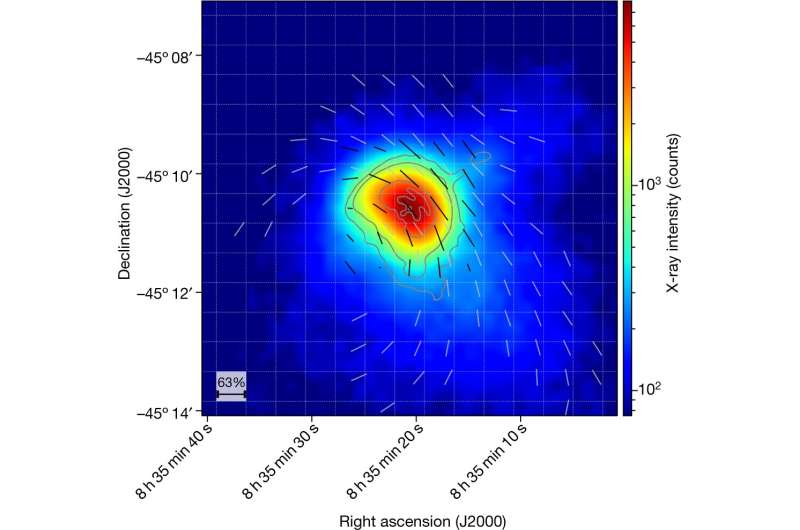January 3, 2023 report
This article has been reviewed according to Science X's editorial process and policies. Editors have highlighted the following attributes while ensuring the content's credibility:
fact-checked
peer-reviewed publication
trusted source
proofread
Imaging the magnetic field in the acceleration zone of the Vela pulsar

An international team of space scientists has imaged the magnetic field that exists in the acceleration zone of the Vela pulsar. In their paper published in the journal Nature, the group describes how they used data from NASA's Imaging X-Ray Polarimetry Explorer (IXPE) mission to obtain indirect imaging of the nebula's magnetic field. Samar Safi-Harb, with the University of Manitoba, has published a News and Views piece in the same journal issue, explaining the background history of the study of the death of massive stars and the work done by the team on this new effort.
Prior research has shown that when huge stars die, they explode as a supernova. The core then generally becomes a pulsar—a very small, rapidly rotating star that remains very highly magnetized. Pulsars are generally shaped roughly like a doughnut, and due to their magnetic field they produce gas clouds around them, called nebula. Nebulas also have what is known as an acceleration zone—where material speeds up as it is pushed by the pulsar wind. In this new effort, the researchers have imaged the magnetic field associated with the acceleration zone of a pulsar known as Vela.
Directly imaging a magnetic field is not possible of course, because it is not visible. To make images of one, astronomers instead use the light that is emitted from particles that are in the process of being accelerated. Such light is generated as magnetic fields force changes in the paths of particles as their speed increases. The photons that are emitted, prior research has shown, tend to vibrate in just one direction—perpendicular to the magnetic field. That means measuring the direction of the vibration can lead scientists to the polarization of the emission, which shows the direction of the magnetic field.
In this new effort, the researchers were able to detect the polarization from Vela using data from IXPE and because of that were able to create images describing the way the magnetic field generated by VELA lights up the area around it, including the impact of the termination shock. The images are described as symmetrical and having a highly ordered structure.
More information: Fei Xie et al, Vela pulsar wind nebula X-rays are polarized to near the synchrotron limit, Nature (2022). DOI: 10.1038/s41586-022-05476-5
Samar Safi-Harb, X-rays reveal the magnetic field lighting up a stellar graveyard, Nature (2022). DOI: 10.1038/d41586-022-04445-2
Journal information: Nature
© 2023 Science X Network





















